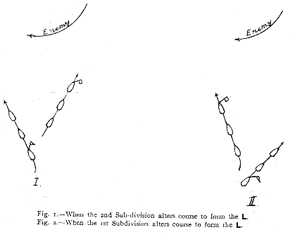
 |
| FEBRUARY 1904 - SEPTEMBER 1905 |
| WAR-DECLARED | PRE-WAR | NEWS AND UPDATES | DOCUMENTS | THE NAVAL CAMPAIGN | THE LAND CAMPAIGN | STORE |
| MAPS AND CHARTS | MEMBERS ARTICLES | CONTACT THE EDITORS | PERSONALITIES | MESSAGE BOARD | LINKS | HOME |
|
Togo's Instructions | Dewa's Instructions | Uriu's Instructions Japanese Battle Instructions [Extracted from the Fleet and Divisional "Confidential Orders"] III. Special Instructions for the Second Division by Admiral Kamimura. 1. These are the main points of the tactics to be employed
when the Second Division engages the enemy alone. Battle Formation. 3. In Battle Formation my flagship will lead the line, the Rear Admirals flagship bringing up the rear. The line will be normally an undulating one, but the formation and order of the ships will be changed when necessary. When this happens the leading ship or that at the end of the wing will take on the duty of leading the fleet without regard to the seniority of its Commanding Officer, and she will conduct the other ships to advantageous positions. Order of Ships. Idzumo (Flag), Adzuma, Asama, Yakumo, Tokiwa,
Iwate (Flag) Battle Speed. 4. Battle Speed is 17 knots and in the absence
of special orders this speed will be used. Slow speed will be 5 knots,
and half speed will be half way between the speed at the moment and
slow speed. Battle Plan. 6. When we engage an enemy of equal or superior
strength we will maintain our original line and use our speed to get
into the T formation with the enemy, concentrating the fire of our whole
line on his leading ship or the end of his line. The chief points of
the tactics to be followed by our leading ship during the action are:-

N.B.- As a result of this maneuver the Subdivisions will become seperated, and considerable loss of power will take place. Therefore they must take great care to maintain connection with one another.
When we are fighting in the L formation and
a return to the T formation seems advantageous, either the 1st or 2nd
Subdivision, according to circumstances, will turn together as convenient
and follow the other Subdivision. Single line ahead will be formed as
convenient without regard to the order of the ships in the line. Use of Guns. 9. There will be no special signals to open fire, this being left to the individual discretion of the officer commanding each ship. At ranges of more than 4,500 meters (4,900 yards) rapid firing is to be avoided, and all preliminary adjustments are to be carried out with the greatest care. At ranges of less than 4,500 meters the adjustments connected with the enemy's speed are to be omitted, and the bow of the ship is to be the point aimed at. Use of Torpedoes. 10. There will be no changes of formation or movement made to close with the enemy in order to get a good opportunity for discharging torpedoes, but preparations are to be made for discharging them and care taken that a possible chance is not let slip. If there is a favorable opportunity of using them during the action, a ship may alter course not more than two points for this purpose, returning as quickly as possible after discharge to the original course. Gunfire and Movements against Destroyers and Torpedo-boats. 11. When destroyers or torpedo-boats are noticed making a rapid approach to attack, you are to fire upon them, aiming at a point half their length ahead of them. Occasionally, to avoid torpedo attacks or to increase gunfire, an alteration of course together will be made. Kamimura
|
| Copyright © 2002 russojapanesewar.com |